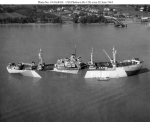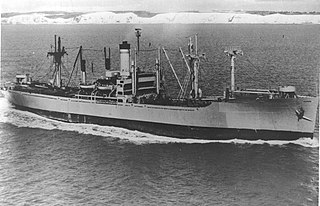
USS Razorback (SS-394), a Balao-class submarine, was the only ship of the United States Navy to be named after the razorback, a species of whale found in the far southern reaches of the Pacific Ocean. She is arguably the longest-serving combat front-line submarine still existing in the world, having been commissioned by two different countries for 56 years of active duty. She was in Tokyo Bay during the surrender of Japan. In 2004, the state of Arkansas adopted the submarine and she is now a museum ship at the Arkansas Inland Maritime Museum.

USS Warrington (DD-843) was a Gearing-class destroyer that served the U.S. Navy from the end of World War II to the Vietnam War, when she was damaged by two underwater explosions, causing her to be listed as "beyond repair" and excessed to the Navy of the Republic of China.

USS Washburn (AKA-108) was a Tolland-class attack cargo ship in service with the United States Navy from 19945 to 1970 She was scrapped in 1980.

USS Wiltsie (DD-716) was a Gearing-class destroyer in the United States Navy. She was named for Irving Wiltsie. The destroyer entered service in 1946 and remained active with the United States Navy until 1977, when Wiltsie was decommissioned and sold to Pakistan in 1977. The vessel entered service with the Pakistan Navy as PNS Tariq (D165) in 1978. In 1990, the ship was renamed PNS Nazim to allow the name Tariq to be given to a newly-acquired Type 21 frigate. The ship was then transferred to the Pakistan Maritime Security Agency and used as an alongside "at sea" headquarters for the agency. Though afloat, the vessel no longer sails.

USNS Harris County (T-LST-822) was an LST-542-class tank landing ship built for the United States Navy during World War II. Named for counties in Georgia and Texas, she was the only U.S. Naval vessel to bear the name.

USS Jason (AR-8) was the fourth of the Vulcan class repair ship of the United States Navy in service from 1944 to 1995, serving in World War II, Korea, Vietnam, and the Gulf War. At the time of her decommissioning, Jason was the oldest ship in continual commission in the United States Navy, and the final ship in continual commission from World War II onward.

USS Delta (AK-29/AR-9) was the lead ship of her class of repair ships in the United States Navy during World War II. She was originally built as the merchant ship SS Hawaiian Packer before her requisition by the U.S. Navy in 1941. Before conversion to a repair ships, Delta briefly served as a U.S. Navy cargo ship.

USS Taluga (AO-62) was a Cimarron-class fleet oiler acquired by the U.S. Navy during World War II. She served her country primarily in the Pacific Ocean Theatre of Operations, and provided petroleum products where needed to combat ships. For performing this dangerous task in combat areas, she was awarded four battle stars during World War II, four during the Korean War, and six campaign stars during the Vietnam War.

USS Tolovana (AO-64) was a Cimarron-class fleet oiler acquired by the U.S. Navy during World War II. She served her country primarily in the Pacific Ocean Theatre of Operations, and provided petroleum products where needed to combat ships. For performing this dangerous task in combat areas, she was awarded one battle star during World War II, two during the Korean War, and thirteen campaign stars and the Navy Unit Commendation during the Vietnam War.

USS Phobos (AK-129) was a Crater-class cargo ship commissioned by the U.S. Navy for service in World War II. She was responsible for delivering troops, goods and equipment to locations in the war zone.

USS Regulus (AF-57) was a Denebola-class stores ship acquired by the United States Navy. Her task was to carry stores, refrigerated items, and equipment to ships in the fleet, and to remote stations and staging areas.

USS Bellatrix (AF-62) was an Alstede-class stores ship in service with the United States Navy from 1961 to 1968, following commercial service from 1945 to 1961. She was scrapped in 1969.
USNS Lt. James E. Robinson (T-AKV-3/T-AG-170/T-AK-274) was a Lt. James E. Robinson-class cargo ship, which was launched as a World War II commercial Victory cargo ship SS Czechoslovakia Victory under the Emergency Shipbuilding program. She had earlier been the U.S. Army's USAT LT. James E. Robinson before being acquired by the U.S. Navy.
USS Herkimer (AK-188) was an Alamosa-class cargo ship that served the US Navy during the final months of World War II. Post-war she served in the Pacific Ocean theatre of operations for some time with the US Army as USAT Herkimer, and then as USNS Herkimer (T-AK-188), with the Military Sea Transportation Service (MSTS) from 1950 to 1973. She was then transferred to the navy of the Trust Territory of the Pacific Islands (TTPI).
USS Muskingum (AK-198/T-AK-198) was an Alamosa-class cargo ship that was constructed for the US Navy under a US Maritime Commission (MARCOM) contract during the closing period of World War II. She supported the end-of-war Navy effort. On 7 March 1946 Muskingum was placed in service under bareboat charter with the US Army under the Shipping Control Authority for the Japanese Merchant Marine with a Japanese crew. In 1950, she was reactivated and placed into service with the Military Sea Transportation Service as USNS Muskingum (T-AK-198) until being struck from the Navy list in 1973. She was ultimately transferred to the Trust Territory of the Pacific Islands (TTPI) and the Republic of Palau.

USNS Sgt. Jack J. Pendleton was a Lt. James E. Robinson-class cargo ship constructed during World War II as a Victory ship and named the SS Mandan Victory. The Mandan Victory was placed into service by the War Shipping Administration's Emergency Shipbuilding program under cognizance of the U.S. Maritime Commission.
SS Greenville Victory was a cargo Victory ship built in 1944, during World War II under the Emergency Shipbuilding program. The ship’s United States Maritime Commission designation was VC2-S-AP3, hull number 18 (V-18). Post-war she was acquired by the U.S. Army and renamed as USAT Greenville Victory. She was acquired by the U.S. Navy in 1950, renamed USNS Greenville Victory (T-AK-237) and assigned to the Military Sea Transportation Service (MSTS) who operated her safely through the Korean War and Vietnam War campaigns. She was the lead ship in her class of 9 ships that were transferred to the MSTS in 1950. She returned home with two battle stars to her credit and was struck in 1987.

USNS Sgt. Andrew Miller (T-AK-242) was built as Victory ship SS Radcliffe Victory, a Boulder Victory-class cargo ship, built at the end of World War II. She served during the war and its demilitarization as a commercial cargo vessel operated by American West African Lines under charter with the Maritime Commission and War Shipping Administration. From 1946 to 1950, she served the US Army as a transport named USAT Sgt. Andrew Miller. In 1950, she was acquired by the US Navy and assigned to the Military Sea Transportation Service (MSTS). In 1981 she ended her career and was placed into reserve.

USNS Lt. George W. G. Boyce (T-AK-251) was a Boulder Victory-class cargo ship built for the U.S. Maritime Commission during the final months of World War II.

USNS Marine Adder (T-AP–193) was a troop ship for the United States Navy in the 1950s. She was built in 1945 for the United States Maritime Commission as SS Marine Adder, a Type C4-S-A3 troop ship, by the Kaiser Company during World War II. In 1950, the ship was transferred to the Military Sea Transport Service of the U.S. Navy as a United States Naval Ship staffed by a civilian crew. After ending her naval service in 1957, she entered the National Defense Reserve Fleet, but was sold for commercial use in 1967. She was used in part to carry supplies to support the Vietnam War efforts. During the summer of ‘72 while in Da Nang harbor, South Vietnam a limpet mine was attached to the hull by a swimmer. The mine blew a hole in the hull. In order to save the ship the Skipper ran it aground in Da Nang harbor. The USS Navy standby salvage ship USS Grasp with its crew of divers installed a box patch over the hole and pumped the water from the bilges, before moving the ship to a pier. US Army tanks hung from ship booms to heel the ship so that a metal patch could be welded in place to return the ship to duty. SS Transcolorado, she was chartered by the Military Sealift Command as a civilian cargo ship designated T-AK-2005.















